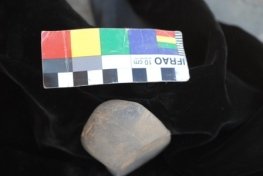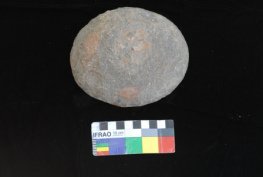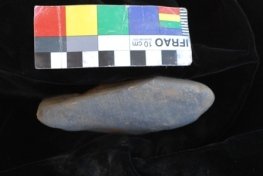Last time we looked at axe grinding grooves, but now I’d like to bring you really close to the edge!
How? By having a look at edge-ground axes, the production of which resulted in the grooves I’ve been looking at for my Directed Study!
The first step Indigenous people had to undertake when manufacturing such an axe was to source the best available raw material. Extreme hardness and toughness were vital, with material like basalt being ideal.
Such material then needed to be flaked into the general desirable shape for grinding to then occur. After grinding to polish the edge to a suitable state of sharpness, the final products were sometimes used as hand-axes, but hafting the axe head on to a wooden handle was also common.



A selection of edge ground axes from north-west Queensland (images courtesy of Lynley Wallis).
Edge ground axes are known to have been widely distributed via extensive trade systems across Australia and sometimes their manufacture occurred at significant distances from their raw material sources and points of trade.
It appears that northern Queensland was a significant axe manufacturing area. Trade from northern Queensland seems to have extended far south into New South Wales and perhaps even into Victoria. It also most likely followed another route, from the Mt Isa region into the Lake Eyre Basin. While axe technology itself is considerably older, their trade within and from Queensland may only have extended as far back as 1000 years ago.
One of the main related research questions to explore in seeking to clarify the nature of such trade is the extent to which there was standardisation of axe manufacture. Standardisation is a strong indicator of trade. As such, determining spatial and temporal patterns of standardisation can prove enlightening.
My analysis of the Rocks Crossing axe grinding grooves, while also exploring whether patterns exist that might relate to other questions, is so far hinting at standardisation of manufacture. Analysis would also of course have to be done on axes themselves that have been found across possible trade routes.
One challenging question is the extent to which different dimensions of axe grinding grooves might reflect axe resharpening, rather than original production. If smaller grooves reflect resharpening, then grooves found in NSW and Victoria may be able to be linked to axes traded from Queensland (although there always exists the possibility that people may, as they moved, have kept their own axes rather than engaged in trade).
For any conclusions on this and other possibilities keep a look out for my upcoming final blog!
For those seeking further reading, valuable insights into uses of raw materials can be seen at http://www.academia.edu/1259545/Biface_distributions_and_the_Movius_Line_A_Southeast_Asian_perspective where discussion focuses on Australian bifacial tools.
For some great photos and illustrations of various forms of axes, see McCarthy, F.D. 1976 Australian Aboriginal Stone Implements. Sydney: The Australian Museum Trust.

